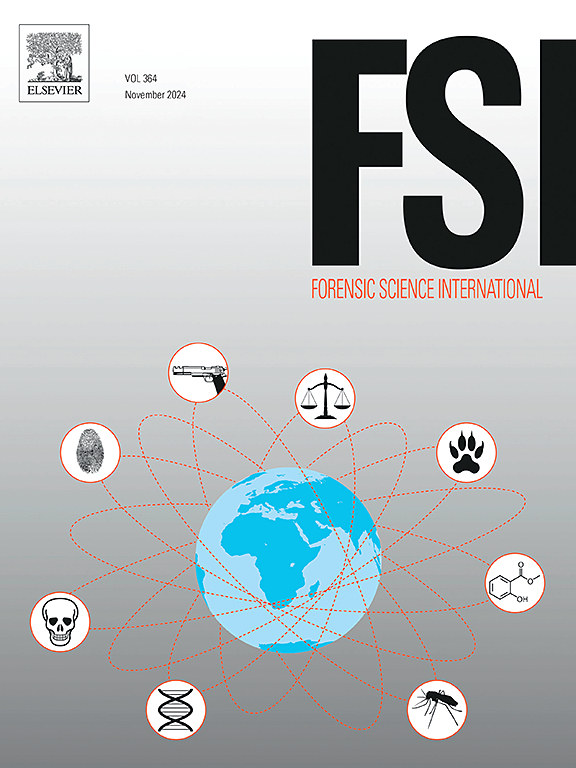从自动指纹识别系统的搜索中比较潜伏指纹判定的准确性和可重复性
IF 2.2
3区 医学
Q1 MEDICINE, LEGAL
引用次数: 0
摘要
本研究旨在评估潜在指纹审查员(LPEs)在将潜在指纹与FBI下一代识别系统(NGI)检索获得的样本进行比较时所做决定的准确性和可重复性。本研究建立在2009年FBI-Noblis潜在指纹鉴证员黑匣子研究的基础上(1,2),并结合了进行多个法医鉴证员研究的经验教训。分析基于156个lpe的14224个回复。每个参与者从总共300个ip中分配了100个潜在样本图像对(ip, 80个非配对,20个配对)。在配对比较中,62.6 %的应答为id(真阳性),4.2 %为错误排除(假阴性),17.5 %为不确定,15.8 %为无值。在非配对比较中,0.2 %的回答是错误的id(假阳性),69.8 %是排除(真阴性),12.9 %是不确定的,17.2 %是没有值。一名参与者在研究中做出了大多数错误的识别,这强调了决策率对研究中个体参与者的高度敏感。不同的lpe没有重复错误的id,但15 %的错误排除被重复。有一种潜在的担忧是,NGI的规模和产生更多相似非数据的能力(与(1,2)中使用的IAFIS相比)会增加假id的风险;然而,我们没有发现观察到的假身份率增加的证据。这些结果表明,NGI搜索的风险缓解战略可能对那些实施了这种战略的机构起作用。本文章由计算机程序翻译,如有差异,请以英文原文为准。
Accuracy and reproducibility of latent print decisions on comparisons from searches of an automated fingerprint identification system
This study was conducted to evaluate the accuracy and reproducibility of decisions made by practicing latent print examiners (LPEs) when comparing latent fingerprints to exemplars that were acquired by searches of the FBI Next Generation Identification system (NGI). This study builds on the 2009 FBI-Noblis latent print examiner black box study (1, 2), incorporating lessons learned from conducting multiple additional forensic examiner studies. Analyses are based on 14,224 responses from 156 LPEs. Each participant was assigned 100 latent-exemplar image pairs (IPs, 80 nonmated and 20 mated) out of a total of 300 IPs. On mated comparisons, 62.6 % of responses were IDs (true positives), 4.2 % were erroneous exclusions (false negatives), 17.5 % were inconclusive, and 15.8 % were no value. On nonmated comparisons, 0.2 % of responses were erroneous IDs (false positives), 69.8 % were exclusions (true negatives), 12.9 % were inconclusive, and 17.2 % were no value. One participant made the majority of the erroneous IDs in the study, which underscores how decision rates can be highly sensitive to the individual participants in a study. No erroneous IDs were reproduced by different LPEs, but 15 % of erroneous exclusions were reproduced. There is a potential concern that NGI’s size and ability to yield much more similar nonmates (as compared to IAFIS used in (1, 2)) poses an increased risk of false IDs; however, we do not find evidence of an increase in the observed false ID rate. These results suggest that risk mitigation strategies for NGI searches may be working for those agencies that have implemented such strategies.
求助全文
通过发布文献求助,成功后即可免费获取论文全文。
去求助
来源期刊

Forensic science international
医学-医学:法
CiteScore
5.00
自引率
9.10%
发文量
285
审稿时长
49 days
期刊介绍:
Forensic Science International is the flagship journal in the prestigious Forensic Science International family, publishing the most innovative, cutting-edge, and influential contributions across the forensic sciences. Fields include: forensic pathology and histochemistry, chemistry, biochemistry and toxicology, biology, serology, odontology, psychiatry, anthropology, digital forensics, the physical sciences, firearms, and document examination, as well as investigations of value to public health in its broadest sense, and the important marginal area where science and medicine interact with the law.
The journal publishes:
Case Reports
Commentaries
Letters to the Editor
Original Research Papers (Regular Papers)
Rapid Communications
Review Articles
Technical Notes.
 求助内容:
求助内容: 应助结果提醒方式:
应助结果提醒方式:


